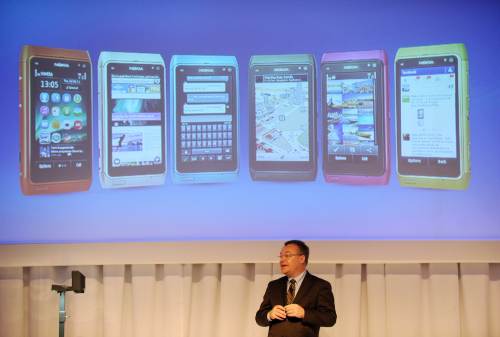Nokia unveils mobile phones in Asia to stem Google, Apple advance
By 이현주Published : June 22, 2011 - 19:02
Nokia Oyj unveiled mobile phones at both ends of its range to fend off competition from cheap unbranded handsets and smartphones powered by Google Inc.’s Android.
The C2-03 model will target consumers in emerging markets by making it easier to switch between different phone numbers, Mary McDowell, the executive vice president who runs low-end phones, said in Singapore Tuesday. Nokia also showed the N9, a touchscreen smartphone based on its MeeGo software that will start shipping later this year.
Chief Executive Officer Stephen Elop is turning his focus toward winning back customers in Asia, home to the world’s two biggest mobile-phone markets, after spending his first months devising a plan to fight Apple Inc.’s iPhone and Android-based devices in Europe and the U.S. Nokia’s market share in China and India tumbled by more than a third last year, according to research firm Gartner Inc.
The C2-03 model will target consumers in emerging markets by making it easier to switch between different phone numbers, Mary McDowell, the executive vice president who runs low-end phones, said in Singapore Tuesday. Nokia also showed the N9, a touchscreen smartphone based on its MeeGo software that will start shipping later this year.
Chief Executive Officer Stephen Elop is turning his focus toward winning back customers in Asia, home to the world’s two biggest mobile-phone markets, after spending his first months devising a plan to fight Apple Inc.’s iPhone and Android-based devices in Europe and the U.S. Nokia’s market share in China and India tumbled by more than a third last year, according to research firm Gartner Inc.

“Nokia recognizes it needs to move more quickly to make up lost ground in emerging markets, particularly India where agile opportunist competitors have taken market share,” said Ben Wood, a London-based analyst with CCS Insight.
Nokia rose as much as 12 cents, or 3 percent, to 4.17 euros and traded at 4.16 euros as of 11:21 a.m. in Helsinki, valuing the Espoo, Finland-based company at 15.6 billion euros ($22 billion). The stock is down 46 percent this year.
“The reality is that 90 percent of the world does not have or cannot afford a smartphone or a high-end device,” said Elop in his first major speech in Asia since the former Microsoft Corp. executive took the helm at Nokia in September last year. “This gap creates an opportunity.”
Elop plans to increase investment in low-end phones that have sold well in Asia as well as emerging-market countries elsewhere. These models accounted for about half of Nokia’s handset revenue and 78 percent of units shipped last year.
They face competition from cheaper Android phones from companies such as ZTE Corp. as well as a flood of unbranded phones from smaller Chinese manufacturers, built on chipsets from MediaTek Inc.
While China led Nokia’s markets in the first quarter with a 30 percent sales increase, the company said May 31 intensifying competition from local suppliers in the country was driving down prices. China and the Asia-Pacific region accounted for 45 percent of Nokia’s device sales in the first quarter. (Bloomberg)
Touch, type
That hasn’t stopped the slide. Its market share in China tumbled to 20.4 percent last year from 31.5 percent in 2009 and in India, Nokia dropped to 30.2 percent from 48.9 percent in one year, according to estimates at Gartner.
The C2-03 model, a touch-and-type device combining a touchscreen and a keypad, will have the ability to carry two SIM cards, facilitating the use of two phone numbers. It will also feature maps and location-based services without the user requiring to sign up for a plan with the carrier.
“Touch and type allows them to introduce something at the low end that other guys don’t have quite yet,” said Mikko Ervasti, an analyst at Evli Bank in Helsinki. “It will help to get some part of the market in the low end.”
Southeast Asia, including Indonesia and Vietnam, as well as India, China, Nigeria, South Africa and Brazil are regions that could yield the “next one billion people” who’ll buy mobile phones, McDowell said.
‘Full swing’
“In the third time in a month, we’re debuting another dual-SIM device,” McDowell said. “We may be late to this party, but we’re in full swing now.”
At the high end, Nokia faces competition from Apple’s iPhone and a welter of Android-based devices that are starting to match the iPhone’s capabilities in apps, Web surfing and media delivery. These touchscreens also integrate increasingly well with corporate e-mail and other systems, making them a threat to Research In Motion Ltd.’s Blackberry line as well.
The N9 user has no buttons on the face and works by swipe and tap gestures on the screen. The touch interface extends to accessories like headphones and speakers which are activated through tapping them using so-called near field communications technology, senior vice president Marko Ahtisaari said.
Nokia last week settled its dispute with Apple over patents including one for wiping gestures on a touchscreen in a deal that gives the Finnish company a one-time payment and royalties.
Symbian phones
Nokia’s “primary smartphone strategy” remains the Windows phone, Elop said, which will be unveiled this year and will begin to ship “in volume” in 2012. Nokia is planning to introduce 10 devices based on Symbian, the software it’s phasing out as it switches to Microsoft’s platform.
Last quarter, Nokia’s handset revenue dipped below Apple’s iPhone sales for the first time. Android smartphone software, offered on devices from dozens of vendors is expected to be the world’s most used smartphone system this year, according to Gartner.
Globally, Nokia’s shipments fell 2.3 percent in the first quarter, driving down its market share more than 5 percentage points to 25.1 percent, according to Gartner. Apple boosted its share to 3.9 percent, ZTE to 2.3 percent and HTC to 2.2 percent.
(Bloomberg)



















![[Today’s K-pop] BTS pop-up event to come to Seoul](http://res.heraldm.com/phpwas/restmb_idxmake.php?idx=642&simg=/content/image/2024/04/17/20240417050734_0.jpg&u=)